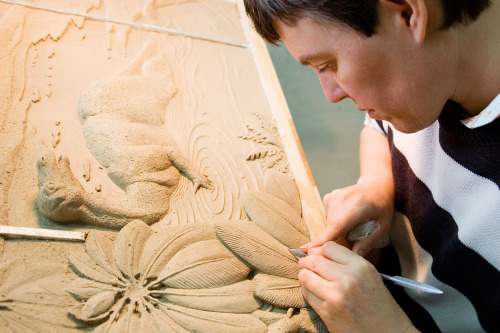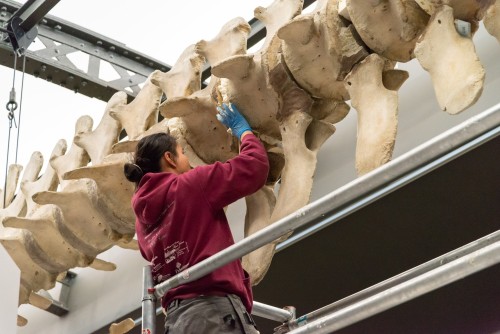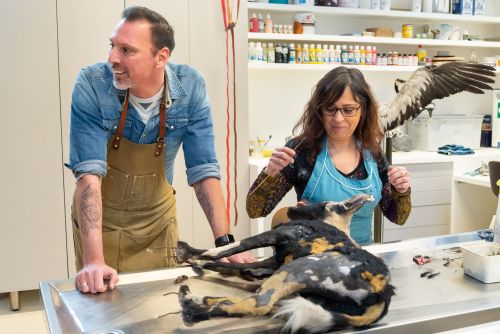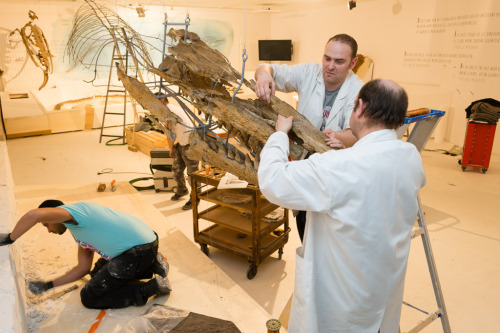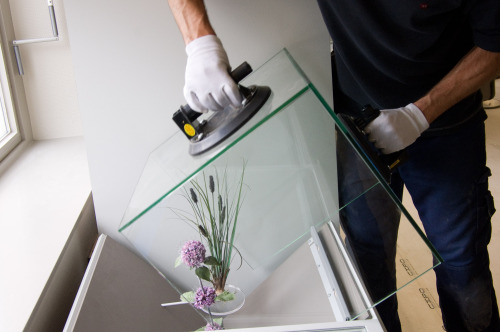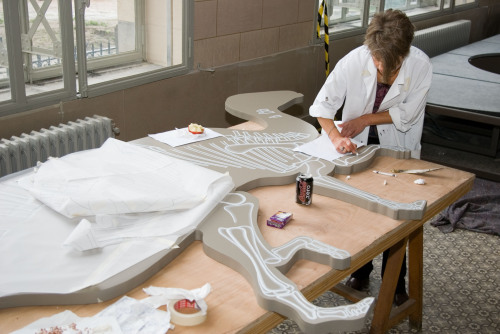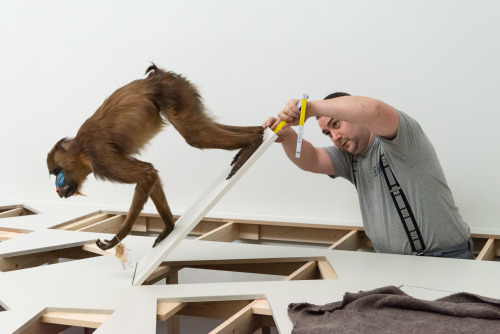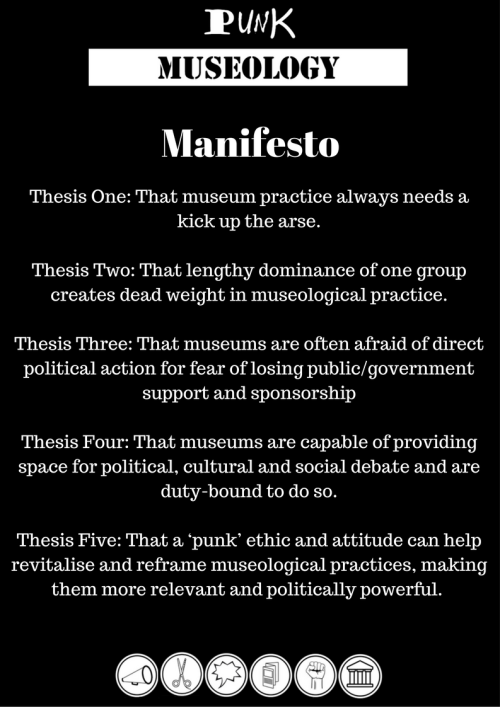#museology
What are some “must-visit” museums or heritage sites where you live?
Muse des Beaux Arts, Montreal
McCord, Montreal
La Guilde, Montreal.
Literally any museum in the Old Port, Montreal.
VanGoghAliveArtExhibition
On one hand, beautiful
On the other, this is a nightmare for conservation and exhibition management
Post link
#MuseumWeek day 2 - A tribute to the creative minds and skilled hands of our museologists and technicians! Imagining, designing, planning, building - a multitude of skills and expertise come together, bringing a gallery to life. Peek behind the scenes of some of our permanent galleries. Recognize them all?
#BehindTheScenesMW
Post link

ICOM Massive Open Online Course: Creating Meaningful and Inclusive Museum Practices
On 29 November the first ICOM Massive Open Online Course (MOOC) will be online and available to all on the Future Learn platform: “Creating Meaningful and Inclusive Museum Practices”. The course will encourage museum professionals to explore a series of methodologies and strategies for social inclusion and community building that can be implemented to support wider cultural participation.
The course was coordinated by the Department of Capacity Building / Museums and Society of ICOM Secretariat, and the content was developed by Armando Perla (El Salvador/Canada) and Deirdre Prins-Solani (South Africa), heritage and museum practitioners with strong experience on the subject.
Using representative case studies and discussions with practitioners, academics and community members, this course presents methodologies and strategies, such as co-curation, oral history, community collecting, inclusive design and conflict resolution. It illustrates a vibrant and evolving museum practice taking place in different corners around the globe.
The 4-week MOOC proposes practices for museums to ensure the inclusion of people who, for whatever reason, have been denied involvement in mainstream economic, political, cultural, and social activities, such as the elderly, persons with disabilities, migrants, minorities, Indigenous peoples, members from the LGBTQI+ and ethno-cultural communities.
At the same time, the instructors will lead the students to participate in self-assessment and peer-reviewed assignments to encourage self-reflection and social learning.
The course will also encourage a reflection on the challenges faced by institutions and practitioners, so that participants can broaden their perspective on the role of contemporary museums in community engagement and equip themselves with the skills to develop meaningful and inclusive museum projects.
This was posted online last year, but I never got round to posting it here.
Empowering Change: Towards a Definition of the Activist Museum
“The potential for activist museums lies in museums acknowledging and harnessing the role they play in shaping society. If museums can inspire action in their visitors to become more active citizens, more engaged in their communities, more involved in democracy at the local, regional and national level, more informed about how their everyday actions can affect real change and empowered to make change happen, the more relevant museums will be.”
You can read my full article on Museum-ID by clicking the link.
Post link
TheVienna City History Museum (Wien Museum) is going to be undergoing some pretty momentous changes in the coming years, and the museum held an event last night to inform interested members of the public of the current status of the developments and offer some tantalising snippets about the direction the museum will take.
Some brief background, although the museum as an entity is 130 years old, the current building and location is a product of the 1950s, a mere 11 years after the end of WWII, the museum opened in the so-called “Haerdtl” building, a modern and innovative building that set the tone for Vienna’s post-war city planning. However, the intervening years has seen the collection and the role of the museum transform and grow, and the current museum is busting at the seams, with revenue-driving temporary exhibitions spread over several floors and a somewhat disjointed feel. The building is also no longer able to completely meet the needs of a modern museum – both technologically, but also in terms of accessibility.
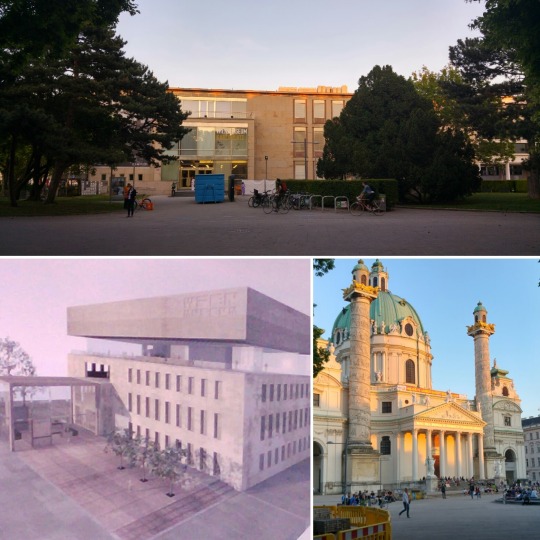
The current Wien Museum (top), the plans for redevelopment (bottom left, Certov, Winkler & Ruck) and the strong competition that is the the Karlskirche next door.
The redevelopment of the museum has not been without controversy – indeed, previous events have been heated and not without the occasional conspiracy theory. This was avoided last night by hiring a friendly but determined moderator to ensure the discussion stayed on track, clearly defining the topics of the evenings discussion. The architectsCertov,Winkler & Ruck from Graz won the global competition, beating over 270 other submissions.Their vision sees the adding of two extra floors to the museum, one offering more room for events, classrooms and ateliers, a lounge area, extra office space and a terrace with views of the city and a second dedicated solely to temporary exhibitions. This top floor will be flexible, it’s possible use ranging from one large exhibition space, to five smaller exhibitions spaces and all manner of possible configurations in between.
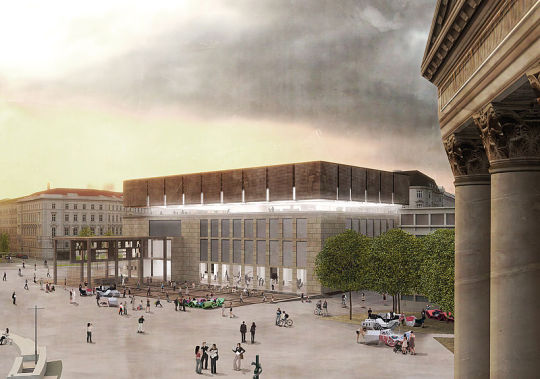
The redevelopment will only ony add more exhibition space and events/educational facilities, but it will also reestablish the museum’s position on the square with a piazza where visitors and non-visitors alike can meet and relax. Picture: Wien Museum
The current museum was built at a time when the square in front of the museum was not a park as it is today, but a busy traffic intersection. Changes to the use and layout of Karlsplatz (named for the bombastic looking Karlskirche ‘Charles Church’) have left the museum somewhat sidelined and easily overlooked, pushed into a corner of the park and quite well-hidden behind trees and play parks. Not only will the new elements take into account the protected status of the original building by adding new floors in a complicated and exciting sounding way, but a new entrance area will shield the new “piazza” area for cafes and events in the front of the museum from the traffic of the nearby road and offer a kind of intermediate zone between the museum and the wider world. The new design will reintroduce the museum on the square, both in terms of presence and use of space.

The current Wien Museum and it’s immediate surroundings on Karlsplatz. Picture: Google Maps.
The New Permanent Exhibition
The museum’s director, Matti Bunzl (see also “A Breakfast with Matti Bunzl, The Vienna City Museum’s Director-in-waiting”), was also on hand to offer some insight into what form the new permanent exhibition might take. The most significant changes will be to the size and scope of the exhibition, increasing from 2000m2 to 3000m2 and bringing the story bang up to date by including a much more substantial look at the 20th century (the exhibition currently stops prior to WWI) and into the 21st century. The changes to the building will make the route through the exhibition more fluid than it currently is, offering visitors a chronological take on Vienna’s history as they ‘corkscrew’ up through the building.
The ground floor will begin with the archaeology of Vienna, leading through to the medieval period (the Wien Museum has several smaller museums throughout Vienna, including the Museum of the Middle Ages in the Stephansplatz tube station – review here) and potentially including a giant model of St Stephens Cathedral, the most famous building in Vienna. The next floor will also feature an outrageously sized object: the original Donnerbrunnen, a monumental fountain commissioned as the first public artwork by the City of Vienna in the 18th century. The fountain is so big that in all likelihood the museum will have to be somehow ‘built around it’, as even the new heavy-duty lift wouldn’t be able to transport it. Vienna’s story continues, including the boom period of the Gründerzeit, which saw Vienna as the capital of vast, multi-ethnic empire, but also the growing gaps between rich and poor, extensive migration from other areas of the empire and rapid technological advancements that made Vienna a vibrant, global metropolis.

The Donnerbrunnen today in Vienna’s first district. The original will be part of the Wien Museum’s new permanent exhibition. Photo: Wikimedia Commons
The third floor will continue the story through the changes, devastations and upheavals of the 20th century: the establishment of two Austrian Republics, the World Wars, Red Vienna, the Holocaust and Nazi Regime, the Cold War, Vienna and the UN, migration post-1960s and showcasing the museum’s art collection (it’s Vienna, so think Klimt and Schiele!)
What Comes Next?
To be able to realise such a wholescale redevelopment the museum will have to close for a period. Matti Bunzl also detailed some of the plans they have to continue the museum’s mission and to ensure that their key audiences remain in touch with the museums and engaged. One very exciting project was the school programme, which will see curators and educators spending a prolonged period in primary schools with the 3rd class (roughly nine years old), focusing not only on Vienna’s history, but also the work of a museum. Over a week, objects and information will be worked up into an exhibition that will then be opened at the end of the week. I would have just exploded with excitement if someone had come to my school to do this when I was nine.
Another programme is to have satellite, mobile exhibitions in slightly more unexpected places around the city.
The Wien Museum Neu project is now entering the public consultation phases and extensive exploratory drilling will be carried out in the coming weeks to head off any nasty surprises when the time comes to build.
You can read more about the project on the website:
Wien Museum Neu (only in German it seems, but lot’s of pictures)
The Wien Museum also had an exhibition that featured not only the winning design, but also the runners-up and special mentions.
Is it floorplansyou’re after?
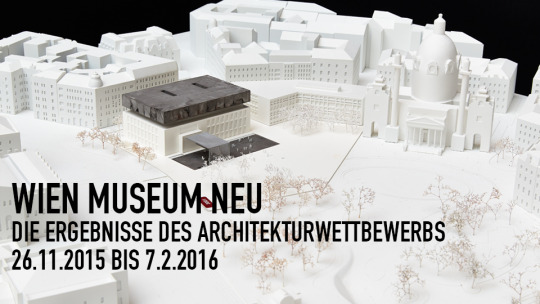
Post link
New Museum Podcast: Queering Museums
A new podcast began in February to mark LGBTQ+ month and is seeking to give an insight into the different way that LGBTQ+ museum workers and people in related fields are changing and shaping museum practice and museums themselves.
In it’s first week, Queering Museums focused on not only the importance of telling queer histories in museums to address how they have long been ignored or silenced, but also the how important it is for young people and the LGBTQ+ community to see their history represented, as well as the different ways that museums and museum professionals are trying to do it.
Each episode features interviews with people from different museums, the project doesn’t limit itself to a particular project or approach. This includes Margaret Middleton who talks about the importance of language, including the family friendly language, that makes space for children from families in all their shapes and constellations (see poster below). Their is also a discussion about how the stories and objects are often already there in museums collections, but have been hidden or obscured by euphemism (great example given about soldiers in the American Civil War). It’s also great to hear from people who work in “less obvious” positions in the museum infrastructure, or those discussing the ways that different types of museum approach the the topics (e.g. Episode 3 when talking about science museums and centres).

Margaret Middleton’s poster summary of family friendly language, buy it here.
The podcast quality is great and the production is slick, which makes it a pleasure to listen to. You can download it via iTunes, listen on Soundcloud or sign up using the podcast app of your choice. And don’t forget to follow their profile on Twitter and those of the masterminds behind the project: Sacha Coward,Russell DornanandShaun O’Boyle.
Current Episodes:
Related reading, projects and exhibitions:
QueeringTheMuseum.org An online resource that states: “We focus on museums due to their ability to shape and define the communities in which we live. QTM believes that museums have a responsibility to account for the role played in constructing normalized ideas of race, gender and sexuality.”
Never Going Underground exhibition at the People’s History Museums in Manchester, opened last week by Ian McKellen and telling the history of the figt for LGBTQ+ rights.
The National Trust’s page on Exploring LGBTQ history at their sites. An interesting looks at how the LGBTQ+ stories become hidden or obscured, but not all are lost forever. Working together with Leicester School of Museum Studies to create a legacy from the 2017 anniversary of partial decriminalisation.
Historic England’s Pride of Place project has a list of aims and objectives, not least - as the body that administers listed buildings in the UK - “nominate buildings or landscapes for consideration for local heritage listing on the basis of their significance to LGBTQ histories”.
Ablogpost by the Te Papa Museum of New Zealand about their LGBTIQ+ collections and their importance in making the histories visible.
The National Archive’s page on the Queer City project.
If you know of any other resources, projects, podcasts or websites that you think should be inclided, get in touch.
Listen here
Post link
Find out more and get involved by visiting www.punkmuseology.com
The manifesto of the Punk Museology project which launched last week. Do you agree?
Go to the website for the more information and to get involved.
Post link



